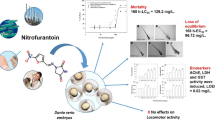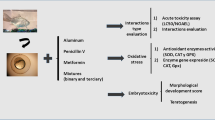Abstract
The individual and combined biochemical responses of erythromycin and ketoconazole have been examined in an organism representative of the aquatic environment, crucian carp (Carassius auratus). The possible interactions between erythromycin and ketoconazole were investigated on the bioaccumulation and the expression of biotransformation enzymes 7-ethoxyresorufin-O-deethylase (EROD) and glutathione S-transferase (GST), and an antioxidant defense enzyme superoxide dismutase (SOD) in fish tissues. After 14 days of combined exposure (erythromycin + ketoconazole), the addition of ketoconazole at nominal concentrations of 0.2, 2, and 20 μg/L significantly increased the accumulation of erythromycin in fish bile; however, elevated erythromycin accumulation levels were not observed in the other test tissues. The inductions of EROD and SOD activity to erythromycin were inhibited by the combined exposure of ketoconazole in most cases; however, the GST activity returned to normal with exposure time and concentration of combined administration. From the tested pharmaceutical mixtures, it indicated that certain specific combinations may pose some perturbations in biochemical responses in fish and also provide a better understanding of the effects of toxic mixtures.


Similar content being viewed by others
References
Aguirre-Martínez GV, Owuor MA, Garrido-Perez C et al (2015) Are standard tests sensitive enough to evaluate effects of human pharmaceuticals in aquatic biota? Facing changes in research approaches when performing risk assessment of drugs. Chemosphere 120:75–85
Ando T, Nagase H, Eguchi K et al (2007) A novel method using cyanobacteria for ecotoxicity test of veterinary antimicrobial agents. Environ Toxicol Chem 26:601–606
Belfroid A, van Velzen M, van der Horst B et al (2002) Occurrence of bisphenol A in surface water and uptake in fish: evaluation of field measurements. Chemosphere 49:97–103
Bradford MM (1976) A rapid and sensitive method for the quantitation of microgram quantities of protein utilizing the principle of protein-dye binding. Anal Biochem 72:248–254
Chen ZF, Ying GG (2015) Occurrence, fate and ecological risk of five typical azole fungicides as therapeutic and personal care products in the environment: a review. Environ Int 84:142–153
Chen F, Gao J, Zhou Q (2012) Toxicity assessment of simulated urban runoff containing polycyclic musks and cadmium in Carassius auratus using oxidative stress biomarkers. Environ Pollut 162:91–97
Corcoran J, Lange A, Cumming RI et al (2014) Bioavailability of the imidazole antifungal agent clotrimazole and its effects on key biotransformation genes in the common carp (Cyprinus carpio). Aquat Toxicol 152:57–65
Ding J, Lu G, Li S et al (2015) Biological fate and effects of propranolol in an experimental aquatic food chain. Sci Total Environ 532:31–39
Ding J, Lu G, Li Y (2016) Interactive effects of selected pharmaceutical mixtures on bioaccumulation and biochemical status in crucian carp (Carassius auratus). Chemosphere 148:21–31
Franzellitti S, Buratti S, Du B et al (2015) A multibiomarker approach to explore interactive effects of propranolol and fluoxetine in marine mussels. Environ Pollut 205:60–69
Gao L, Shi Y, Li W et al (2012) Occurrence of antibiotics in eight sewage treatment plants in Beijing, China. Chemosphere 86:665–671
González-Ortegón E, Blasco J, Le Vay L et al (2013) A multiple stressor approach to study the toxicity and sub-lethal effects of pharmaceutical compounds on the larval development of a marine invertebrate. J Hazard Mater 263:233–238
González-Pleiter M, Gonzalo S, Rodea-Palomares I et al (2013) Toxicity of five antibiotics and their mixtures towards photosynthetic aquatic organisms: implications for environmental risk assessment. Water Res 47:2050–2064
Hegelund T, Ottosson K, Rådinger M et al (2004) Effects of the antifungal imidazole ketoconazole on CYP1A and CYP3A in rainbow trout and killifish. Environ Toxicol Chem 23:1326–1334
Huang Q, Yu Y, Tang C et al (2010) Determination of commonly used azole antifungals in various waters and sewage sludge using ultra-high performance liquid chromatography–tandem mass spectrometry. J Chromatogr A 1217:3481–3488
Islas-Flores H, Gómez-Oliván LM, Galar-Martínez M et al (2013) Diclofenac-induced oxidative stress in brain, liver, gill and blood of common carp (Cyprinus carpio). Ecotox Environ Safe 92:32–38
Ji K, Kim S, Han S et al (2012) Risk assessment of chlortetracycline, oxytetracycline, sulfamethazine, sulfathiazole, and erythromycin in aquatic environment: are the current environmental concentrations safe? Ecotoxicology 21:2031–2050
Kümmerer K (2009) Antibiotics in the aquatic environment—a review—part I. Chemosphere 75:417–434
Koenig S, Fernández P, Solé M (2012) Differences in cytochrome P450 enzyme activities between fish and crustacea: relationship with the bioaccumulation patterns of polychlorobiphenyls (PCBs). Aquat Toxicol 108:11–17
Kolpin DW, Furlong ET, Meyer MT et al (2002) Pharmaceuticals, hormones, and other organic wastewater contaminants in us streams, 1999-2000: a national reconnaissance. Environ Sci Technol 36:1202–1211
Laville N, Aıt-Aıssa S, Gomez E et al (2004) Effects of human pharmaceuticals on cytotoxicity, EROD activity and ROS production in fish hepatocytes. Toxicology 196:41–55
Letzel M, Metzner G, Letzel T (2009) Exposure assessment of the pharmaceutical diclofenac based on long-term measurements of the aquatic input. Environ Int 35:363–368
Li SW, Lin AYC (2015) Increased acute toxicity to fish caused by pharmaceuticals in hospital effluents in a pharmaceutical mixture and after solar irradiation. Chemosphere 139:190–196
Li W, Shi Y, Gao L et al (2012b) Occurrence of antibiotics in water, sediments, aquatic plants, and animals from Baiyangdian Lake in North China. Chemosphere 89:1307–1315
Li Z, Lu G, Yang X et al (2012a) Single and combined effects of selected pharmaceuticals at sublethal concentrations on multiple biomarkers in Carassius auratus. Ecotoxicology 21:353–361
Lin T, Yu S, Chen Y et al (2014) Integrated biomarker responses in zebrafish exposed to sulfonamides. Environ Toxicol Pharmacol 38:444–452
Liu J, Wang R, Huang B et al (2011) Distribution and bioaccumulation of steroidal and phenolic endocrine disrupting chemicals in wild fish species from Dianchi Lake, China. Environ Pollut 159:2815–2822
Liu J, Wong M (2013) Pharmaceuticals and personal care products (PPCPs): a review on environmental contamination in China. Environ Int 59:208–224
Liu J, Lu G, Ding J et al (2014) Tissue distribution, bioconcentration, metabolism, and effects of erythromycin in crucian carp (Carassius auratus). Sci Total Environ 490:914–920
Liu J, Lu G, Xie Z, Zhang Z et al (2015a) Occurrence, bioaccumulation and risk assessment of lipophilic pharmaceutically active compounds in the downstream rivers of sewage treatment plants. Sci Total Environ 511:54–62
Liu J, Lu G, Zhang Z et al (2015b) Biological effects and bioaccumulation of pharmaceutically active compounds in crucian carp caged near the outfall of a sewage treatment plant. Environ Sci Proc Impacts 17:54–61
Liu J, Lu G, Yang H et al (2016) Bioconcentration and metabolism of ketoconazole and effects on multi-biomarkers in crucian carp (Carassius auratus). Chemosphere 150:145–151
Lu G, Yang X, Li Z et al (2013) Contamination by metals and pharmaceuticals in northern Taihu Lake (China) and its relation to integrated biomarker response in fish. Ecotoxicology 22:50–59
Lu G, Wang C, Zhu Z (2009) The dose–response relationships for EROD and GST induced by polyaromatic hydrocarbons in Carassius auratus. Bull Environ Contam Toxicol 82:194–199
Lushchak VI, Bagnyukova TV (2006) Temperature increase results in oxidative stress in goldfish tissues. 2. Antioxidant and associated enzymes. Comp Biochem Physiol C: Toxicol Pharmacol 143:36–41
Marklund S, Marklund G (1974) Involvement of the superoxide anion radical in the autoxidation of pyrogallol and a convenient assay for superoxide dismutase. Eur J Biochem 47:469–474
Nunes B, Gaio AR, Carvalho F et al (2008) Behaviour and biomarkers of oxidative stress in Gambusia holbrooki after acute exposure to widely used pharmaceuticals and a detergent. Ecotox Environ Safe 71:341–354
OECD (2012) OECD Guideline for Testing of Chemicals. No. 305, Bioaccumulation in Fish: Aqueous and Dietary Exposure. OECD, Paris
Orias F, Simon L, Mialdea G et al (2015) Bioconcentration of 15 n-tamoxifen at environmental concentration in liver, gonad and muscle of Danio rerio. Ecotox Environ Safe 120:457–462
Peng X, Huang Q, Zhang K et al (2012) Distribution, behavior and fate of azole antifungals during mechanical, biological, and chemical treatments in sewage treatment plants in China. Sci Total Environ 426:311–317
Puckowski A, Mioduszewska K, Łukaszewicz P et al (2016) Bioaccumulation and analytics of pharmaceutical residues in the environment: a review. J Pharm Biomed Anal 127:232–255
Riley RJ, Howbrook D (1997) In vitro analysis of the activity of the major human hepatic CYP enzyme (CYP3A4) using [N-methyl-14C]-erythromycin. J Pharmacol Toxicol Methods 38:189–193
Risso-de Faverney C, Lafaurie M, Girard JP et al (2000) The nitroxide stable radical tempo prevents metal-induced inhibition of CYP1A1 expression and induction. Toxicol Lett 111:219–227
Roberts J, Kumar A, Du J et al (2016) Pharmaceuticals and personal care products (PPCPs) in Australia's largest inland sewage treatment plant, and its contribution to a major Australian river during high and low flow. Sci Total Environ 541:1625–1637
Rocco L, Peluso C, Stingo V (2012) Micronucleus test and comet assay for the evaluation of zebrafish genomic damage induced by erythromycin and lincomycin. Environ Toxicol 27:598–604
Solé M, Shaw JP, Frickers PE et al (2010) Effects on feeding rate and biomarker responses of marine mussels experimentally exposed to propranolol and acetaminophen. Anal Bioanal Chem 396:649–656
Valavanidis A, Vlahogianni T, Dassenakis M et al (2006) Molecular biomarkers of oxidative stress in aquatic organisms in relation to toxic environmental pollutants. Ecotox Environ Safe 64:178–189
Valdés M, Huerta B, Wunderlin D et al (2016) Bioaccumulation and bioconcentration of carbamazepine and other pharmaceuticals in fish under field and controlled laboratory experiments. Evidences of carbamazepine metabolization by fish. Sci Total Environ 557:58–67
Yan Z, Lu G, Wu D et al (2013) Interaction of 17β-estradiol and ketoconazole on endocrine function in goldfish (Carassius auratus). Aquat Toxicol 132:19–25
Yan Z, Lu G, Ye Q et al (2016) Modulation of 17β-estradiol induced estrogenic responses in male goldfish (Carassius auratus) by benzo[a]pyrene and ketoconazole. Environ Sci Pollut Res 23:9036–9045
Ye A, Yang Y, Zhang J et al (2013) Simultaneous determination of steroidal and phenolic endocrine disrupting chemicals in fish by ultra-high-performance liquid chromatography–mass spectrometry/mass spectrometry. J Chromatogr A 1278:126–132
Zanger UM, Schwab M (2013) Cytochrome P450 enzymes in drug metabolism: regulation of gene expression, enzyme activities, and impact of genetic variation. Pharmacol Ther 138:103–141
Acknowledgments
This study was supported by the National Science Funds for Creative Research Groups of China (Grant 51421006), the National Natural Science Foundation of China (Grant 516030611), the Fundamental Research Funds for the Central Universities (Grant 2015B12114, 2015B16314, 2014b12514), the Yarlung Zangbo Scholars of Agricultural and Animal Husbandry College of Tibet University (2015XYA01), and the Priority Academic Program Development of Jiangsu Higher Education Institutions.
Author information
Authors and Affiliations
Corresponding author
Additional information
Responsible editor: Cinta Porte
Electronic supplementary material
ESM 1
Supplemental material. (DOC 55 kb)
Rights and permissions
About this article
Cite this article
Liu, J., Lu, G., Cai, Y. et al. Modulation of erythromycin-induced biochemical responses in crucian carp by ketoconazole. Environ Sci Pollut Res 24, 5285–5292 (2017). https://doi.org/10.1007/s11356-016-8268-7
Received:
Accepted:
Published:
Issue Date:
DOI: https://doi.org/10.1007/s11356-016-8268-7




